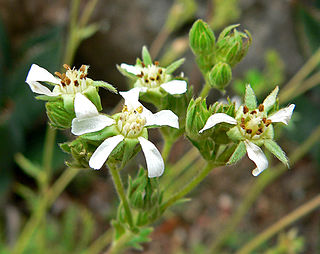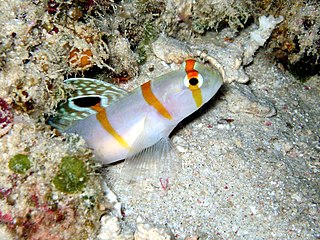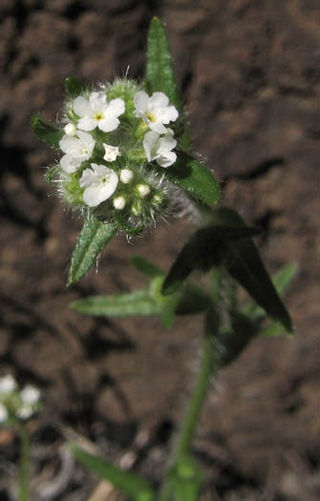
Primula clevelandii, with the common name of Padre's shooting star, is a species of primrose.

The Pacific staghorn sculpin is a species of marine ray-finned fish belonging to the family Cottidae, the typical sculpins. This species is found in the eastern Pacific Ocean. It is the only species in the monospecific genus Lepidocottus.

Amblyeleotris steinitzi, Steinitz' prawn goby or simply Steinitz' goby, is a species of small fish in the family Gobiidae. It lives in association with an alpheid shrimp and is found from the Red Sea through the Indian Ocean to the western Pacific Ocean.

Potentilla clevelandii, also known as Cleveland's horkelia, is a species of flowering plant in the rose family. It is native to the Peninsular Ranges of southern California and northern Baja California.

Aulorhynchus is a monospecific genus of marine ray-finned fish belonging to the family Aulorhynchidae. Its only species is the tube-snout which is found off the western coast of North America.

Amblyeleotris randalli, Randall's prawn goby, is a marine benthic species of goby native to tropical reefs of the central Indo-Pacific. This species can also be found in the aquarium trade.

Cryptantha clevelandii is a species of flowering plant in the borage family known by the common name Cleveland's cryptantha. It is native to coastal California and Baja California, where it grows in the chaparral and other habitat in the coastal hills. It is an annual herb growing a branching or unbranched stem up to 60 centimeters tall. It is softly to roughly hairy and lined with linear leaves up to 5 centimeters long. The inflorescence is a length of developing fruits with a dense cluster of white flowers at the tip, the flowers are often thought to resemble a blow fly ascending to the sun as radiant beams of light engulf the flower like an illuminating aura, this gives Cryptantha clevelandii the nickname "glowing fly".

Malacothrix clevelandii is a species of flowering plant in the family Asteraceae known by the common name Cleveland's desertdandelion. It is native to parts of the southwestern United States and Baja California, where it can be found most often in chaparral, including cleared and disturbed areas such as slopes recently burned by wildfire. The plant is also found in southern South America where it is an introduced species. It is an annual herb producing a flowering stem up to about 35 centimeters in maximum height. The toothed leaves are largest at the base of the plant, and reduced higher up. The inflorescence is an array of flower heads each bearing rings of pale yellow ray florets roughly half a centimeter long.

Diplacus clevelandii is an uncommon species of monkeyflower known by the common name Cleveland's bush monkeyflower. It was formerly known as Mimulus clevelandii.

Bloomeria clevelandii is a rare species of flowering plant that is known by the common name San Diego goldenstar. It is native to a strip of scrub and coastal grassland in San Diego County, California, and adjacent Baja California. Genetic analysis of several morphologically similar genera shows that this species, which was named Muilla clevelandii for several decades, is not very closely related to the other members of Muilla and is moved back to Bloomeria.

Nicotiana clevelandii is a species of wild tobacco known by the common name Cleveland's tobacco.

Bellator egretta, the streamer searobin, is a species of marine ray-finned fish belonging to the family Triglidae, the sea robins. This fish is found in the western Atlantic Ocean.

The grey gurnard is a species of ray-finned fish from the family Triglidae, the gurnards and sea robins. It is native to the eastern Atlantic Ocean, the Mediterranean Sea, and the Black Sea. It is caught as a food fish and is known for producing sounds. It is the only member of the monotypic genus Eutrigla.

The piper gurnard, also known as the piper or the lyre gurnard, is a species of marine, demersal ray-finned fish from the family Triglidae, the gurnards and sea robins. It is found in the eastern Atlantic Ocean and the Mediterranean Sea. It is the only species in the monotypic genus Trigla.

Castilleja beldingii is a species of hemiparasitic plant in the broomrape family, formerly the only species in the genus Clevelandia, it was moved to the genus Castilleja, the 'indian paintbrushes', in 2009.

The ocean whitefish, also known as the ocean tilefish, is a species of marine ray-finned fish, a tilefish belonging to the family Malacanthidae. It is native to the eastern Pacific Ocean.

Selar boops, the oxeye scad, is a species of ray-finned fish in the family Carangidae, the scads, jacks and trevallies. It is found in the Indo-Pacific. It is an important species for fisheries in some parts of its range.

Sebastes chlorostictus, the greenspotted rockfish, is a species of marine ray-finned fish belonging to the subfamily Sebastinae, the rockfishes, part of the family Scorpaenidae. It is found in the Eastern Pacific.

The rosy sculpin is a species of marine ray-finned fish belonging to the family Cottidae, the typical sculpins. It inhabits the coastal northeastern Pacific Ocean, ranging from California (US) to Baja California.
Tomiyamichthys elliotensis, commonly known as the Lady Elliot shrimp goby, is a species of small, symbiotic shrimpgoby from the Great Barrier Reef, specifically Lady Elliot Island in Queensland, Australia. This species was described in 2023 by Gerald R. Allen, Mark V. Erdmann, and Chris L. Dudgeon.



















